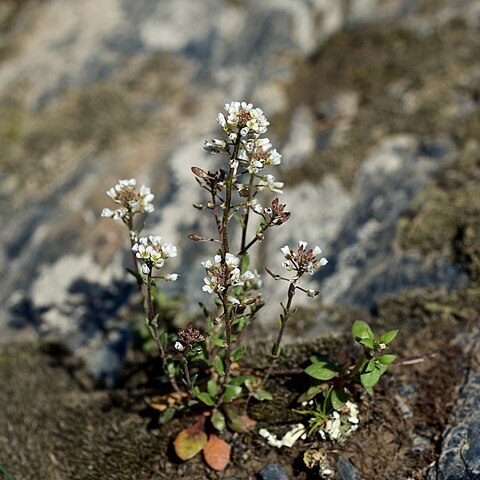Annuals; not scapose. Stems usually branched, rarely unbranched, (0.3-)0.4-1.9 (-2.2) dm, pubescent through-out, trichomes sessile, cruciform, 0.2-0.6(-0.8) mm (rays often equal, or those parallel to stem axis longer). Basal leaves not rosulate; petiolate; petiole (to 0.5 cm), not ciliate; blade oblanceolate to obovate, 0.5-2 cm × 2-8 mm, margins entire, surfaces pubescent, trichomes cruciform, 0.2-0.6(-0.8) mm. Cauline leaves (4-)6-11; sessile; blade lanceolate to oblong or linear, margins entire, surfaces pubescent as basal. Racemes (main branch) (20-)25-65(-74)-flowered, ebracteate, elongated in fruit; rachis not flexuous, pubescent as stem. Fruiting pedicels horizontal to divaricate-ascending, straight, (1-)1.5-4(-5) mm, pubescent, trichomes cruciform. Flowers: (late ones cleistogamous, apetalous); sepals (green or pink), oblong, 0.7-1.2(-1.5) mm, pubescent; petals white, spatulate, 2-3 × 0.8-1.1 mm; anthers ovate, 0.15-0.25 mm. Fruits usually elliptic to linear-elliptic, rarely ovate-elliptic, plane, flattened, (2-)2.5-5(-6) × 0.9-1.4(-1.9) mm; valves glabrous; ovules 8-16(-20) per ovary; style 0.05-0.1 mm. Seeds (winged), ovoid, 0.5-0.7 × 0.4-0.5 mm. 2n = 16.
More
Annual or winter-annual to 2 dm, usually much-branched; basal lvs few and evanescent, elliptic to obovate; cauline lvs narrower, the uppermost nearly linear; racemes all elongate at maturity, 2–6 cm; pedicels ascending, glabrous to minutely stellate, usually 2–3 mm; pet white or yellow, to 3 mm, or none; frs oblong-elliptic, 2.5–4 × 0.8–1.4 mm, glabrous; 2n=16, 24. Dry woods and fields; Va. to Ind. and Kans., s. to Fla. and Tex. Mar.–May.

